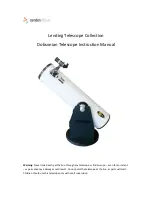
11
Orion Nebula(M42):
Right ascension:
05: 35.4 (hours: minutes)
Declination:
-05: 27 (degrees: minutes)
Distance:
Approximately 1,344 light years
The Orion Nebula is a vast star-forming region located in
the “sword” branching off of the famous Orion’s Belt. Also
known as Messier 42, this diffuse nebula is bright enough to
see with the unaided eye — although it will only appear as a
slightly foggy star. However, with your telescope, you can see
many of the beautiful details, such as the billowing clouds of
gas and dust where new stars are being born.
Image credit: NASA, ESA, M. Robberto (Space Telescope Science Institute/ESA)
and the Hubble Space Telescope Orion Treasury Project Team
11
Pleiades Star Cluster(M45):
Right ascension:
03: 47.0 (hours: minutes)
Declination:
+24: 07 (degrees: minutes)
Distance:
Approximately 444 light years
The Pleiades Star Cluster is a group of brilliant blue
stars located in the Taurus Constellation. Also known
as Messier 45 or “Seven Sisters”, this open star cluster
consists of more than 1,000 confirmed stars, although
an average of only six are visible to the unaided eye.
With your telescope, you can quickly reveal some
of the more elusive members of this legendary and
beautiful cluster.
Image credit: NASA/JPL-Caltech/UCLA
Dumbbell Nebula(M27)
Right ascension:
19:59.6 (hours: minutes)
Declination:
+22:43 (degrees: minutes)
Distance:
Approximately 1,360 light years
The Dumbbell Nebula was the first planetary nebula
ever discovered. It is one of the most popular sights
in the Vulpecula constellation. Easy to find with
binoculars and amazing in a telescope, the shape of
this bright, double-lobed nebula has been compared
to a dumbbell, an hourglass or an apple core. As an
added bonus, the white dwarf that lies at the heart of
the Dumbbell Nebula is larger than any other star of
its kind.
Image credit: NASA/JPL-Caltech/Harvard-Smithsonian CfA
Andromeda Galaxy(M31):
Right ascension:
00: 42.7 (hours: minutes)
Declination:
+41: 16 (degrees: minutes)
Distance:
Approximately 2.54 million light years
The Andromeda Galaxy is the closest major galaxy
to our own Milky Way. Also known as Messier 31,
this famous spiral galaxy is part of the Local Group
of galaxies. Although it is technically bright enough
to see with the unaided eye under a very dark sky,
your telescope may show its bright center, hints of
its spiral structure and its much smaller companion
galaxies known as M32 and M110.
Image credit: NASA/JPL-Caltech
Note: Images are for illustration purposes only. Quality of your image may very depending upon atmospheric conditions and location.






























